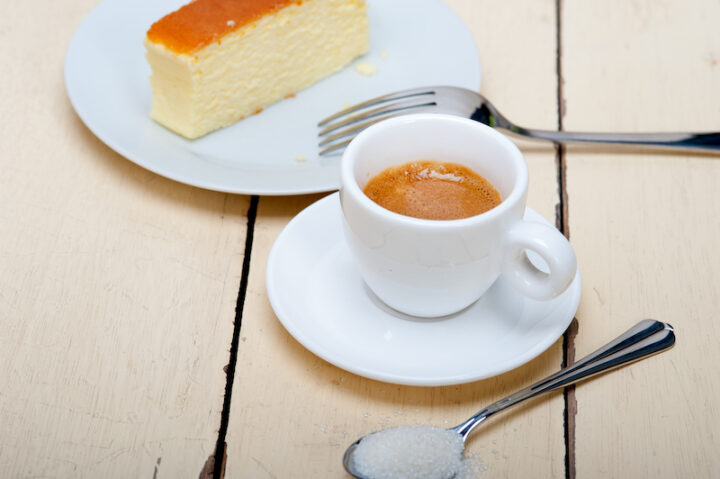No two cultures are entirely the same. While most Western cultures are fairly similar, there are still minor differences that make each culture beautifully unique. Sometimes these differences seem strange or even counter-intuitive to foreigners. For example, Italians struggle to understand why Americans insist on building everything “bigger” in hopes of making it “better.” Americans, on the other hand, often have trouble understanding these 20 quirks in Italian culture.
Ogni cultura è un mondo a sé. Anche se molte culture occidentali possono sembrare simili, ci sono piccole differenze che le rendono straordinariamente uniche. Queste diversità, a volte, possono apparire curiose o persino strane agli occhi di chi viene da lontano. Gli italiani, ad esempio, trovano incomprensibile la mania americana di costruire tutto “più grande” credendo che “più grande” sia meglio. Allo stesso modo, gli americani spesso faticano a comprendere queste 21 peculiarità della cultura italiana.

This article is part of our Bilingual Blog series, where we share useful information and tips about non-language related aspects of Italian culture such as food, music, travel and more. These articles have been written in Italian and English to give our readers the opportunity to improve their reading skills whilst learning something new about Italy.
1. The Bidet
A bidet is a must-have appliance in Italy. Almost every bathroom, both private and public, will have both a toilet and a bidet in Italy. In private homes, it is common to find a towel rack positioned alongside the bidet for conveniently drying oneself after using it. It’s uncommon to find public toilets with bidets, and even when there is one, no Italian would use a public bidet for hygienic reasons. Conversely, it’s quite common for public restrooms to lack toilet paper, so it’s always a good idea to carry some tissues.
Il Bidet
Il bidet è un oggetto fondamentale per gli italiani. Ogni bagno privato, dal più modesto al più lussuoso, è dotato di water e bidet. Quest’ultimo, è spesso accompagnato da un pratico portasciugamani per asciugarsi comodamente dopo l’uso. Nei bagni pubblici, invece, non sempre si trova e, quando c’è, nessun italiano lo userebbe per motivi igienici. È invece piuttosto comune non trovare carta igienica nei bagni pubblici, per questo è saggio avere sempre con sé dei fazzoletti.

2. Beware Wet Hair
Leaving the house with wet hair is considered a significant health risk in Italy. If your hair is wet, you are likely to catch a cold – or so says every Italian mamma. While this belief may have some scientific basis or simply be a product of superstition, every Italian household and hotel is equipped with a fon (hairdryer) to ensure that Italians step out looking their best and minimize the risk of falling ill.
2. Attenzione ai capelli bagnati
In Italia, uscire di casa con i capelli bagnati è considerato un pericolo per la salute. Se i vostri capelli sono ancora umidi, potreste prendere un raffreddore, o per lo meno così credono le mamme italiane. Indipendentemente dalla validità di questa convinzione, tutte le case e gli hotel in Italia hanno un asciugacapelli, così gli italiani possono uscire di casa ben pettinati e senza il rischio di ammalarsi.

3. Peeled Fruit (Including Grapes)
I remember how shocked my Italian host family was the first time they saw me stuff a grape (chicco d’uva) in my mouth, skin and all. Many Italians prefer their fruits peeled: apples, pears, peaches, and even grapes! You will come across some Italians who don’t mind consuming their fruits intact, but they constitute the minority. The majority of Italians will cut their fruit into smaller pieces using a knife and fork.
3. La frutta si sbuccia (uva compresa)
Ricordo ancora lo stupore della mia famiglia ospitante italiana quando mi videro mangiare un chicco d’uva senza sbucciarlo. La maggior parte degli italiani, infatti, preferisce la frutta sbucciata: mele, pere, pesche e persino uva! Alcuni italiani mangiano la frutta con la buccia, ma sono una minoranza. Inoltre, la frutta viene di solito tagliata in pezzi più piccoli con coltello e forchetta.

4. Cappuccinos after 12pm
Cappuccinos are undeniably delicious, and you may find yourself craving a little sweet coffee in the middle of the day. However, Italians avoid consuming large quantities of milk after breakfast. For this reason, most Italians consider cappuccinos as a morning drink, to be enjoyed before or with breakfast. The substantial amount of milk is considered “heavy” on the body and is believed to disrupt digestion if consumed too late in the day.
That being said, especially among the younger generations, this “rule” is changing. It is now less scandalous for a young person to be seen drinking a cappuccino in the afternoon, although never with a meal, as it is considered too “heavy” for the body.
4. Il cappuccino dopo le 12:00
Il cappuccino è buonissimo, ma in Italia è una bevanda riservata strettamente alla mattina. Gli italiani evitano di consumare grandi quantità di latte dopo colazione, considerandolo troppo pesante per la digestione.
Tuttavia, questa tradizione sta cambiando tra i giovani, e non è più così raro vedere qualcuno sorseggiare un cappuccino nel pomeriggio. Ma attenzione: mai durante i pasti, sarebbe troppo pesante per il corpo.

5. Il Bacetto
When greeting someone in Italy, it is very common to follow Ciao, buongiorno, come stai? (Hello, good day, how are you?) with a couple of cheek-kisses. These kisses are light, and often not even directly touching your check.
This practice is generally accepted among friends and family but not typically practiced among colleagues, especially someone you’ve just met.
5. Il Bacetto
In Italia, quando si saluta qualcuno, è molto comune accompagnare un “Ciao, buongiorno, come stai?” con un paio di baci sulle guance. Sono baci leggeri, spesso non si tocca nemmeno la guancia.
È un gesto molto comune tra amici e familiari, ma meno frequente tra colleghi e tendenzialmente da evitare se ci si è appena conosciuti.

6. No Swimming After Eating
You may have heard it said: you should wait 30 minutes after eating before going swimming. Italians, however, take this suggestion seriously. Some Italians believe you have to wait a whole 3 hours between the last bite of food and the first dip in the pool. During this time, your body is able to digest all of the food, thus leaving your body prepared to exercise and swim. Healthy digestion is very important in Italian culture.
6. Non si nuota dopo aver mangiato
Avete mai sentito dire che bisogna aspettare 30 minuti dopo mangiato prima di tuffarsi in acqua? Bene, in Italia questa raccomandazione è presa molto sul serio, tanto che alcuni credono addirittura che sia necessario aspettare ben 3 ore tra l’ultimo boccone e il primo tuffo. Questo per permettere al corpo di digerire completamente, preparandosi così al meglio per l’attività fisica e il nuoto. Una buona digestione è un pilastro della cultura italiana.

7. Il Colpo d’Aria
Italians suffer from a handful of unique ailments unknown to Americans. One such ailment is colpo d’aria – literally “hit of air” – believed to cause various health issues ranging from earaches and sore throats to headaches and stomachaches. Italians attribute these problems to exposure to cold air, including a cold blast from an air conditioner or a chilly breeze hitting the skin when one is sweaty. As a precaution, Italians often wear scarves and layers for protection, even when the temperature starts to rise outside. Colpo d’aria is considered a genuine health concern among Italians, but Americans? Not so much!
7. Il Colpo d’Aria
Gli italiani soffrono di una serie di disturbi sconosciuti agli americani. Uno di questi è il colpo d’aria, ritenuto responsabile di vari problemi tra cui mal di orecchio, mal di gola, mal di testa e mal di stomaco. Gli italiani, infatti, attribuiscono questi disturbi all’esposizione all’aria fredda, sia che provenga da un condizionatore che da una brezza improvvisa sulla pelle sudata. Per precauzione, spesso indossano sciarpe e strati di vestiti per proteggersi, anche quando le temperature iniziano a salire. Il colpo d’aria è un vero pericolo per la salute degli italiani, ma per gli americani? Pressoché inesistente!

8. Don’t Break the Spaghetti
Sometimes, I will break my spaghetti noodles in half before I cook a single serving so that they fit entirely in the small pot. Maybe you do too. But mi raccomando (listen to me and take my advice), don’t try that in front of a native Italian. It is a personal offence. Spaghetti is meant to be kept whole. The spaghetti, as it cooks, will soften and slip into the water. Don’t break the spaghetti, whatever you do.
This rule applies, not just during cooking, but also while eating them. In fact, you will never see an Italian cut his or her spaghetti with a knife, unless it is to help a young child. The beauty of spaghetti lies in twirling them around the fork, ensuring each bite is coated in delicious sauce!
8. Gli spaghetti non si spezzano
A volte mi capita di rompere gli spaghetti a metà prima di cuocerli per farli entrare completamente in una pentola piccola. Forse lo fate anche voi. Ma mi raccomando, non fatelo mai davanti a un italiano. Spezzare gli spaghetti è considerato un sacrilegio. Devono essere cucinati interi, poiché durante la cottura si ammorbidiscono e scivolano nell’acqua da soli. Dunque, qualsiasi cosa tu faccia, non spezzare gli spaghetti.
Questa regola non vale solo per la cottura, ma anche a tavola. Non vedrete mai un italiano tagliare gli spaghetti con il coltello, a meno che non si tratti di aiutare un bambino piccolo. In fondo, la bellezza degli spaghetti sta proprio nell’arrotolarli intorno alla forchetta, assicurandosi che ogni boccone sia avvolto di delizioso sugo!

9. Late Evening Dinner
Italians tend to prefer their dinner later in the night. Up north, most Italians consider 7 or 8pm to be the ideal dinnertime. Further south, however, Italians will often finish cooking dinner and start eating as late as 10 o’clock!
9. Si cena tardi
Gli italiani hanno l’abitudine di cenare più tardi rispetto ad altre culture. Al nord, l’orario ideale per la cena è intorno alle 19 o alle 20, ma spostandosi verso sud, non è raro iniziare a cenare anche alle 22!

10. Children Out Late at Night
For that same reason, most Italians don’t conclude their serata (evening) until much later in the night. It is not uncommon to see entire families, including small children, out and about at 9 or 10 p.m. on weekends. This is not a sign of poor parenting, but an appreciation for quality family time. In Italy, the lives of children are not separated from the lives of adults. Children eat the same restaurant food as the grown-ups (no menus for children) and stay out as late as the adults.
10. I bambini stanno fuori fino a tardi
In Italia, le serate si concludono tardi e non è raro vedere intere famiglie, inclusi i bambini piccoli, fuori casa anche alle 21 o 22 durante il fine settimana. Non è questione di essere permissivi, ma di valorizzare il tempo di qualità trascorso insieme. La vita dei bambini non è separata da quella degli adulti: mangiano le stesse cose nei ristoranti (niente menù speciali) e restano fuori fino a tardi proprio come i grandi.

11. La Pausa Pranzo
An old-time tradition that is still held by many Italians in small towns is the envy of every American: a 3-hour lunch break. The pausa pranzo is a long break meant to bring families together for the traditionally most important meal of the day: pranzo (lunch). During this period, both workers and students have ample time to return home and enjoy a delightful meal with their families, with sufficient time afterward to indulge in a post-meal nap, or pennichella.
11. La pausa pranzo
In molti piccoli paesi italiani, la pausa pranzo è un’antica tradizione che continua a vivere e viene invidiata da molti americani: tre ore dedicate al pasto più importante della giornata, il pranzo. Questo lungo intervallo permette a lavoratori e studenti di tornare a casa, gustare un buon pasto in famiglia e concedersi una rilassante pennichella.

12. My Birthday, My Treat
In American tradition, the birthday boy or girl is usually treated to dinner by their dear guests. However, in Italian tradition, especially in the south, it’s the other way around. The party guests are treated a special dinner paid for by the birthday boy or girl. For this reason, it is becoming increasingly common for young people to host their birthday dinner at their own home, serving home-cooked food, in order to keep costs low.
That said, some people still love to throw lavish birthday parties for very young kids, even though they won’t remember a thing later on!
12. Offre il festeggiato
In Italia, specialmente al sud, è il festeggiato che offre la cena agli ospiti, contrariamente a quanto avviene in America. È infatti comune che il festeggiato organizzi una cena speciale per i suoi invitati. Per contenere i costi, i giovani spesso scelgono di festeggiare a casa, preparando piatti fatti in casa. Ma non manca chi ama organizzare feste sontuose anche quando i festeggiati sono bambini molto piccoli che nella maggior parte dei casi non si ricorderanno nulla!

13. High Carb Diets! They Work!
By some miracle, most Italians have a fabulously slim figure. But why is that? The foods Italy is most famous for are high in carbs! How is it possible that Italians have such lovely, thin shapes when they eat pasta, pizza, and panini daily? The truth most likely lies in other aspects of Italian culture, such as the tradition of walking where you need to go or the use of high quality ingredients with fewer preservatives.
13. Le diete ricche di carboidrati!
È un vero mistero per molti: come fanno gli italiani a mantenere una figura snella nonostante i cibi per cui il Paese è famoso siano così ricchi di carboidrati? Pasta, pizza e panini sono alimenti quotidiani, eppure gli italiani sfoggiano silhouette invidiabili. Il segreto risiede probabilmente in alcuni aspetti della cultura italiana, tra cui camminare ovunque e l’uso di ingredienti di alta qualità con pochi conservanti.

14. Alla moda
Athleisure may be perfectly acceptable to wear out of the house in America, but in Italy, your sweatpants will need to bear the Gucci symbol in order to be considered out-of-house appropriate. Italians have a near-magical ability to dress well all the time – even in luxurious fashionable athleisure. Italians (actually, many European cultures) have a concept of “house clothes” and “normal clothes”. Your comfiest sweatpants are only meant for wearing around the house after school or work. The clothes you are seen wearing outside must always make you look well put-together according to Italians.
14. Essere alla moda
Negli Stati Uniti, l’abbigliamento sportivo è comunemente accettato fuori casa. In Italia, però, i pantaloni della tuta devono almeno essere firmati Gucci per essere considerati appropriati. Gli italiani hanno una straordinaria abilità nel vestirsi bene in ogni occasione – persino con abbigliamento sportivo di lusso – e, come molte culture europee, distinguono tra “vestiti da casa” e “vestiti normali”. Quindi, i comodi pantaloni della tuta sono da usare solo a casa dopo una lunga giornata. Fuori casa, gli abiti devono sempre riflettere uno stile impeccabile secondo gli italiani.

15. Downing Espresso
Espresso is meant to be downed in one go – like a shot. It is not meant to be sipped and savoured like an American coffee. In fact, most Italians drink their espresso standing up, right at the cafe counter where they bought it.
15. L’espresso va bevuto tutto d’un fiato
L’espresso si beve tutto d’un fiato, proprio come uno shot. Non è una bevanda da gustare lentamente come il caffè americano. Gli italiani lo bevono direttamente al bancone del bar, in piedi, senza perdere tempo.

16. No Tips
In America, we tip everyone. Taxi drivers, baristas, the pizza delivery guy, the waiter at the restaurant, everyone! In Italy, they don’t. Unless the patron received exceptionally excellent service, Italians typically don’t leave a tip, nor do the workers expect one. One of the few exceptions to this “no tipping” rule is for private services, such as a private driver, tour guide, or the porter at your hotel if you’ve got huge and heavy luggage.
16. Niente mance
Negli Stati Uniti, lasciare la mancia è la norma – dal tassista al barista, fino al ragazzo che consegna la pizza. Ma in Italia, è tutta un’altra storia. Gli italiani non lasciano la mancia, a meno che il servizio non sia stato eccezionale, né i lavoratori non se l’aspettano. Le uniche eccezioni sono per servizi privati come autisti, guide turistiche o il portiere dell’hotel se aiuta con bagagli particolarmente pesanti.

17. Hand Gestures
Most languages have a form of Sign Language for deaf and hard of hearing communities. Italian has a formal sign language, of course, but they also have an agreed-upon hand gestures used by everyone. Without using any spoken words, Italians can convey sentences such as “this girl is crazy”, “I think Giulio and Martina are an item now”, and “let’s leave this place” with hand gestures alone. Additionally, these hand gestures are used in conjunction with the spoken language. It is very hard for Italians to talk and keep their hands still. Speaking with one’s hands is an intuitive part of the Italian language!
17. L’arte di gesticolare
La maggior parte dei Paesi ha una lingua dei segni per le comunità sorde e con problemi di udito. Anche l’Italia ne ha una, ma in generale parlare senza usare le mani è quasi impossibile nella quotidianità. Con un semplice movimento della mano, gli italiani possono comunicare frasi come “questa ragazza è pazza”, “Giulio e Martina stanno insieme ora”, o “andiamocene da qui”. Questi gesti accompagnano il linguaggio parlato e per gli italiani è estremamente naturale muovere le mani durante la conversazione. Insomma, parlare con le mani è una parte intuitiva della lingua italiana!

18. Crazy Drivers
Italy is a beautiful country with a beautiful culture. One of the not-so-beautiful aspects, however, is their driving. Italians are notoriously crazy (dare I say, reckless) drivers. Traffic laws, traffic signs, and stripes on the road are not hard-set rules; instead, Italians view them as mere suggestions. They merge without using blinkers, they create their own parking spaces in the middle of road medians, and Vespas and motorbikes have the right to drive in between lanes and cut through traffic wherever they fit. Don’t get me started on Italian roundabouts – they are the thing of nightmares!
18. Guidatori spericolati
L’Italia è rinomata per la sua bellezza e cultura, ma anche per i suoi audaci guidatori. Le regole del traffico e i segnali stradali sono spesso considerati suggerimenti anziché obblighi. Gli italiani si immettono nel traffico senza usare le frecce, parcheggiano dove vogliono e Vespe e moto sfrecciano tra le corsie senza problemi. E vogliamo parlare delle rotonde? Un vero e proprio incubo!

19. Sweet Breakfast
Breakfast in Italy is a sweet and simple affair. You won’t see Italians piling their plates high with loads of breakfast foods. And you certainly won’t see them eating something as savoury as bacon and eggs. A typical Italian breakfast consists of caffè or cappuccino and a sweet pastry or even a few cookies.
19. La colazione è dolce
In Italia, la colazione è un momento dolce e semplice. Non troverete piatti stracolmi di cibi, né tantomeno li vedrete mangiare piatti salati come uova e pancetta. La tipica colazione italiana consiste in un caffè o cappuccino accompagnato da qualcosa di dolce, ad esempio un cornetto o qualche biscotto.

20. Smoking
In recent decades, the United States has had a change in public view of smoking thanks to propaganda and statements by the Surgeon General. Nowadays, most Americans view smoking as a bad habit. This social attitude is not generally shared by Italians. In Italy, smoking is extremely common. Approximately ¼ of the Italian population smokes socially. You will even find ash trays on most outdoor restaurant patios.
That said, some cities are implementing rules that prohibit smoking outdoors when there are children or pregnant women and within five to ten meters of anyone else without their explicit consent.
20. Un popolo di fumatori
Negli Stati Uniti, il fumo è ormai visto come un’abitudine dannosa, grazie alle campagne di sensibilizzazione e alle dichiarazioni del Surgeon General. In Italia, invece, è ancora molto diffuso e socialmente accettato. Circa un quarto della popolazione fuma e i portacenere sono una presenza comune all’esterno dei ristoranti. Tuttavia, alcune città stanno facendo passi avanti, implementando regolamenti che vietano di fumare all’aperto in presenza di bambini, donne incinte, e a meno di cinque o dieci metri da altre persone senza il loro esplicito consenso.

Bonus: La passeggiata
While Americans rely on cars to go pretty much anywhere, Italians hold a deep reverence for the art of walking. However, in Italy, walking transcends mere transportation; it is a cherished ritual of relaxation. Known as la passeggiata, this leisurely stroll is less about reaching a specific destination and more about immersing oneself in the city’s vibrant atmosphere, engaging in delightful people-watching, and savoring una boccata d’aria (a breath of fresh air). Whether strolling with friends, in contemplative solitude, or enjoying a family outing, la passeggiata offers an opportunity to rejuvenate one’s spirit and embrace the simple pleasures of living in the moment.
Bonus: La passeggiata
Mentre per gli americani l’auto è il mezzo principale per spostarsi ovunque, gli italiani amano camminare. Tuttavia, non si tratta semplicemente di spostarsi da un punto all’altro. In Italia, camminare è un vero e proprio rituale di relax. Molte volte, infatti, la passeggiata non ha lo scopo di raggiungere una destinazione precisa, ma rappresenta un momento per immergersi nell’atmosfera della città, osservare le persone e respirare aria fresca. Che siate in compagnia di amici, persi nei vostri pensieri o insieme alla famiglia, una passeggiata è l’occasione perfetta per rinvigorire lo spirito e godersi il presente.

Heather Broster is a graduate with honours in linguistics from the University of Western Ontario. She is an aspiring polyglot, proficient in English and Italian, as well as Japanese, Welsh, and French to varying degrees of fluency. Originally from Toronto, Heather has resided in various countries, notably Italy for a period of six years. Her primary focus lies in the fields of language acquisition, education, and bilingual instruction.


